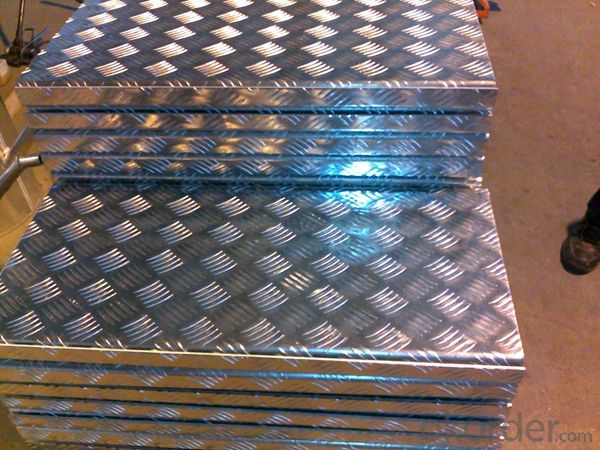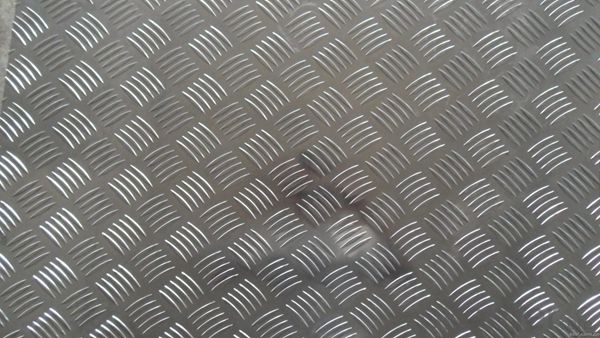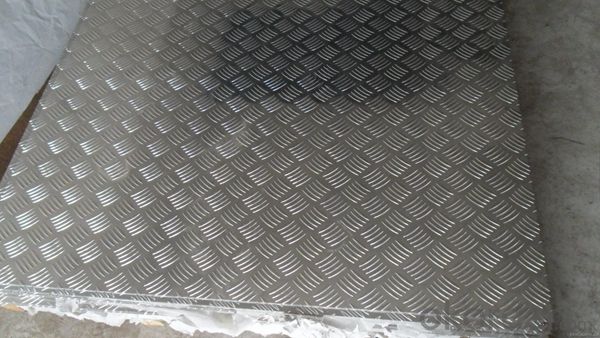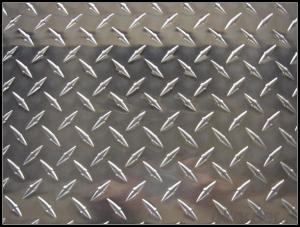Mill Finished Checkered Aluminium Plate 5005 Alloy for Automotive
- Loading Port:
- Shanghai
- Payment Terms:
- TT OR LC
- Min Order Qty:
- 5 m.t.
- Supply Capability:
- 10000 m.t./month
OKorder Service Pledge
OKorder Financial Service
You Might Also Like
Item specifice
1. Specification of Mill Finished Checkered Aluminium Plate 5005 Alloy for Automotive
EQUIPMENT | Double coating double baking; |
CAPACITY | 5000Mt/week |
SIZE | Thickness 0.18mm—2mm, width 40mm—1250mm |
PAINT THICKNESS | Top:18--25um, back:5-7um |
COIL WGT | 3Mt - 8Mt |
COIL ID | φ508mm,φ610mm |
SURFACE PAINT | EP, PE, HDP, SMP, PVDF |
COLOR SERIES | RAL color number series |
2. Application of Mill Finished Checkered Aluminium Plate 5005 Alloy for Automotive
(1).Interior: wall cladding, ceilings, bathrooms, kitchens and balconies, shutters, doors...
(2).Exterior: wall cladding, facades, roofing, canopies, tunnels,column covers , renovations...
(3).Advertisement: display platforms, signboards, fascia, shop fronts...
3. Feature of Mill Finished Checkered Aluminium Plate 5005 Alloy for Automotive
Surfact Quality :
Be free from Oil Stain, Dent, Inclusion, Scratches, Stain, Oxide Dicoloration, Breaks, Corrosion, Roll Marks, Dirt Streaks and other defect which will interfere with use,
Mechenical Property:
Chemical Composite and Mechanical Property
4. Certificate:
SGS and ROHS(if client request, paid by client), MTC(plant provided), Certificate of Origin(FORM A, FORM E, CO), Bureau Veritas and SGS (if client request, paid by client), CIQS certificate
5. Image of Mill Finished Checkered Aluminium Plate 5005 Alloy for Automotive



6. Package and shipping of Mill Finished Checkered Aluminium Plate 5005 Alloy for Automotive
First, plastic cloth with drying agent inside; Second, Pearl Wool ; Third, wooden cases with dry agent , fumigation wooden pallets, aluminum surface could cover blue PVC film
7. FAQ
1) What is the delivery time?
Dpends on actual order, around 20 to 35 days
2)What is the QC system:
We have QC staff of 20 persons and advanced equipment, each production is with MTC traced from Aluminum ingot lot.
3) What market do you mainly sell to?
Australia, America, Asia, Middle East, Western Europe, Africa etc
- Q:Can aluminum sheets be used in electrical applications?
- Aluminum sheets have the capability to be employed in electrical applications. Due to its adeptness in conducting electricity, aluminum is frequently utilized in diverse electrical components and applications. In power transmission lines, bus bars, and electrical enclosures, aluminum sheets are frequently employed as conductive materials. Moreover, their exceptional thermal conductivity properties make them valuable in the production of capacitors, transformers, and heat sinks. Furthermore, aluminum sheets are lightweight and resistant to corrosion, rendering them appropriate for electrical applications where weight and durability are crucial considerations.
- Q:could aluminum sheet be attracted by magnet?
- no, it couldn't.
- Q:What are the different edge treatments available for aluminum sheets?
- Aluminum sheets offer a range of edge treatments, each with its own purpose or aesthetic appeal. Some commonly used edge treatments for aluminum sheets are as follows: 1. Mill Finish: The standard treatment leaves the sheet's raw edges untouched, resulting in a smooth, unfinished look. 2. Trimmed: This treatment involves trimming and smoothing the rough edges of the sheet to create a clean, rounded edge. Techniques like shearing or milling are often employed. 3. Deburred: Sharp edges are removed through deburring, which typically involves filing or sanding. This process ensures a smoother and safer edge. 4. Rolled: By bending the edges inward or outward, rolled edges provide added strength and rigidity to the sheet while enhancing its appearance. 5. Anodized: Anodizing involves immersing the sheet in an electrolytic solution and applying an electric current. This creates a protective oxide layer that can be colored, resulting in an attractive and durable edge finish. 6. Powder Coated: Dry powder paint is applied to the sheet and then heated to form a hard, protective finish. This treatment allows for a variety of colors and textures to be achieved. 7. Brushed: Abrasive materials are used to brush the sheet, creating a visually appealing textured edge. Brushed finishes are often chosen for decorative purposes. 8. Polished: The sheet is buffed to create a smooth and reflective surface. Polishing is commonly utilized in architectural and decorative applications to enhance the edge's appearance. These examples illustrate the range of edge treatments available for aluminum sheets. The choice of treatment depends on factors such as the intended use, desired aesthetics, and functional requirements of the sheet.
- Q:How do you join aluminum sheets together?
- To join aluminum sheets together, there are various methods available depending on the specific application and desired joint strength. The following techniques are commonly used: 1. Welding: Aluminum can be welded using gas tungsten arc welding (GTAW or TIG), gas metal arc welding (GMAW or MIG), or laser welding. These processes involve melting the aluminum at the joint and introducing a filler material to create a strong bond. Welding offers excellent strength and durability, but it requires skill and suitable equipment. 2. Riveting: Aluminum sheets can be fastened together using rivets. This technique involves drilling holes through the sheets and using a rivet gun to insert and deform a rivet, creating a secure joint. Riveting is a relatively simple and quick method, but its strength may not match that of welding. 3. Adhesive bonding: Industrial adhesive bonding is a popular method for joining aluminum sheets. Specialized adhesives formulated for aluminum bonding are applied to the surfaces, which then cure and form a strong bond. Adhesive bonding is advantageous as it evenly distributes stress and can join dissimilar materials. However, it may not be suitable for high-temperature or high-stress applications. 4. Mechanical fasteners: Aluminum sheets can be fastened together using screws, bolts, or nuts. This involves drilling holes and using fasteners to secure the sheets. Mechanical fasteners provide good strength and allow for disassembly if needed. However, they may require additional maintenance and can cause stress concentrations around the holes. 5. Clinching: Clinching is a cold joining method where aluminum sheets are pressed together using a punch and die. This process deforms the materials and creates a mechanical interlock, resulting in a strong joint. Clinching is a quick and cost-effective method, although it may not be suitable for thin or highly rigid sheets. Ultimately, the choice of joining method depends on factors such as the required strength, aesthetics, cost, and ease of fabrication. It is advisable to seek guidance from a qualified professional or follow specific guidelines to ensure a successful and reliable joint.
- Q:Are aluminum sheets suitable for beverage cans?
- Yes, aluminum sheets are suitable for beverage cans. Aluminum is lightweight, resistant to corrosion, and can be easily shaped into cans. It also provides a protective barrier against light and air, ensuring the quality and freshness of the beverages inside.
- Q:aluminum is 2.82x10^-8 ohm-m
- Aluminum with the same resistance as 50 meters of copper. (Resistance) = (Resistivity)(Length/Area) So if the resistivity changes by (2.82/1.72), then the length changes by (1.72/2.82). So the length of aluminum would be 50m(1.72/2.82) Length of aluminum would be 30.5 meters
- Q:i went on the apple education site cuz i was gonna order an aluminum today, and it isnt there anymore!!!! i was on it like 2 hours ago and it was...wtf!!! anyone know whuts up?
- Yes...All Aluminium Macbooks are now turned to Macbook Pros. So might want to try the Mid 2009 white macbook or you have to go with 13 Macbook Pro... vist www.parithi for details..
- Q:Can aluminum sheet be used for solar panels?
- Yes, aluminum sheet can be used for solar panels. Aluminum is a commonly used material in the construction of solar panels due to its combination of strength, durability, and lightweight properties. It is often used as the frame or mounting structure for the panels, providing support and stability. Additionally, aluminum is highly resistant to corrosion, which is important for solar panels that are exposed to the elements. Furthermore, aluminum is a highly conductive material, allowing for efficient transfer of electricity generated by the solar cells within the panel. Overall, using aluminum sheet in the construction of solar panels helps enhance their performance, longevity, and overall efficiency.
- Q:the aluminium pull tabs are in a jucy juice bottle
- 82% okorder /
- Q:Can the aluminum sheets be used for manufacturing chemical reaction vessels?
- Yes, aluminum sheets can be used for manufacturing chemical reaction vessels. Aluminum is a versatile material that offers several advantages for this purpose. It is lightweight, durable, and has excellent corrosion resistance, making it suitable for containing various chemicals and reacting with them. Moreover, aluminum is relatively easy to shape and form into the desired vessel design, allowing for flexibility in manufacturing. However, it is important to note that aluminum may not be suitable for all chemical reactions, especially those involving highly corrosive or reactive substances. In such cases, alternative materials that can withstand the specific reaction conditions may be more appropriate.
1. Manufacturer Overview |
|
|---|---|
| Location | |
| Year Established | |
| Annual Output Value | |
| Main Markets | |
| Company Certifications | |
2. Manufacturer Certificates |
|
|---|---|
| a) Certification Name | |
| Range | |
| Reference | |
| Validity Period | |
3. Manufacturer Capability |
|
|---|---|
| a)Trade Capacity | |
| Nearest Port | |
| Export Percentage | |
| No.of Employees in Trade Department | |
| Language Spoken: | |
| b)Factory Information | |
| Factory Size: | |
| No. of Production Lines | |
| Contract Manufacturing | |
| Product Price Range | |
Send your message to us
Mill Finished Checkered Aluminium Plate 5005 Alloy for Automotive
- Loading Port:
- Shanghai
- Payment Terms:
- TT OR LC
- Min Order Qty:
- 5 m.t.
- Supply Capability:
- 10000 m.t./month
OKorder Service Pledge
OKorder Financial Service
Similar products
New products
Hot products
Hot Searches
Related keywords



























